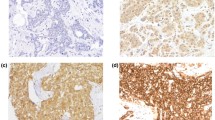Abstract
Ras–GTPase activating protein SH3 domain-binding proteins 1 and 2 (G3BP1 and G3BP2) have recently been reported to be encoded by two separate genes on human chromosomes 5 and 4 respectively and have been implicated in Ras signalling, NFkappaB signalling, the ubiquitin proteosome pathway and RNA processing. In addition, G3BP1 has recently been implicated in cancer biology. The transcripts for these genes have been shown to be universally expressed; however, this is not the case for the proteins which appear to be tissue and cell type specific. We report here the expression of G3BP1 and 2 in human breast cancers and present the first data showing that G3BP2 expression is specific in human breast cancer tissue and was over-expressed in 88% of tumours examined (n = 58).
Similar content being viewed by others
References
Almendral JM, Sommer D, Macdonald-Bravo H, Burckhardt J, Perera J, Bravo R (1988) Complexity of the early genetic response to growth factors in mouse fibroblasts. Mol Cell Biol 8: 2140–2148.
Barlat I, Maurier F, Duchesne M, Guitard E, Tocque B, Schweighoffer F (1997) A role for Sam68 in cell cycle progression antagonized by a spliced variant within the KH domain. J Biol Chem 272: 3129–3132.
Barnes CJ, Li F, Mandal M, Yang Z, Sahin AA, Kumar R (2002) Heregulin induces expression, ATPase activity, and nuclear localization of G3BP, a Ras signaling component, in human breast tumors. Cancer Res 62: 1251–1255.
Cross M, Dexter TM (1991) Growth factors in development, transformation, and tumorigenesis. Cell 64: 271–280.
Duchesne M, Schweighoffer F, Parker F, Clerc F, Frobert Y, Thang MN, Tocque B (1993) Identification of the SH3 domain of GAP as an essential sequence for Ras-GAP-mediated signaling. Science 259: 525–528.
Elston CW, Ellis IO (1990) Pathology and breast screening. Histopathology 16: 109–118.
Gallouzi IE, Parker F, Chebli K, Maurier F, Labourier E, Barlat I, Capony JP, Tocque B, Tazi J (1998) A novel phosphorylationdependent RNase activity of GAP-SH3 binding protein: A potential link between signal transduction and RNA stability. Mol Cell Biol 18: 3956–3965.
Guitard E, Parker F, Millon R, Abecassis J, Tocque B (2001) G3BP is overexpressed in human tumors and promotes S phase entry. Cancer Lett 162: 213–221.
Kenan DJ, Query CC, Keene JD (1991) RNA recognition: Towards identifying determinants of specificity. Trends Biochem Sci 16: 214–220.
Kennedy D, Wood SA, Ramsdale T, Tam PP, Steiner KA, Mattick JS (1996) Identification of a mouse orthologue of the human ras-GAPSH3-domain binding protein and structural confirmation that these proteins contain an RNA recognition motif. Biomed Pept Proteins Nucleic Acids 2: 93–99.
Kennedy D, French J, Guitard E, Ru K, Tocque B, Mattick J (2001) Characterization of G3BPs: Tissue specific expression, chromosomal localisation and rasGAP(120) binding studies. J Cell Biochem 84: 173–187.
Kociok N, Esser P, Unfried K, Parker F, Schraermeyer U, Grisanti S, Toque B, Heimann K (1999) Upregulation of the RAS-GTPase activating protein (GAP)-binding protein (G3BP) in proliferating RPE cells. J Cell Biochem 74: 194–201.
Malumbres M, Pellicer A (1998) RAS pathways to cell cycle control and cell transformation. Front Biosci 3: d887–912.
McGuckin MA, Walsh MD, Hohn BG, Ward BG, Wright RG (1995) Prognostic significance ofMUC1epithelial mucin expression in breast cancer. Hum Pathol 26: 432–439.
Menard S, Tagliabue E, Campiglio M, Pupa SM (2000) Role of HER2 gene overexpression in breast carcinoma. J Cell Physiol 182: 150-162.
Parker F, Maurier F, Delumeau I, Duchesne M, Faucher D, Debussche L, Dugue A, Schweighoffer F, Tocque B(1996)ARas-GTPase-activating protein SH3-domain-binding protein. Mol Cell Biol 16: 2561–2569.
Pazman C, Mayes CA, Fanto M, Haynes SR, Mlodzik M (2000) Rasputin, the Drosophila homologue of the RasGAP SH3 binding protein, functions in ras-and Rho-mediated signaling. Development 127: 1715–1725.
Prigent M, Barlat I, Langen H, Dargemont C (2000) IkappaBalpha and IkappaBalpha/NF-kappa B complexes are retained in the cytoplasm through interaction with a novel partner, RasGAP SH3-binding protein 2. J Biol Chem 275: 36441–36449.
Quimby BB, Lamitina T, L'Hernault SW, Corbett AH (2000) The mechanism of ran import into the nucleus by nuclear transport factor 2. J Biol Chem 275: 28575–28582.
Saksela K, Cheng G, Baltimore D (1995) Proline-rich (PxxP) motifs in HIV-1 Nef bind to SH3 domains of a subset of Src kinases and are required for the enhanced growth of Nef+ viruses but not for down-regulation of CD4. EMBO J 14: 484–491.
Siomi H, Dreyfuss G (1997) RNA-binding proteins as regulators of gene expression. Curr Opin Genet Dev 7: 345–353.
Soncini C, Berdo I, Draetta G (2001) Ras-GAP SH3 domain binding protein (G3BP) is a modulator of USP10, a novel human ubiquitin specific protease. Oncogene 20: 3869–3879.
Sueoka E, Goto Y, Sueoka N, Kai Y, Kozu T, Fujiki H (1999) Heterogeneous nuclear ribonucleoprotein B1 as a new marker of early detection for human lung cancers. Cancer Res 59: 1404–1407.
Suyama M, Doerks T, Braun IC, Sattler M, Izaurralde E, Bork P (2000) Prediction of structural domains ofTAP reveals details of its interaction with p15 and nucleoporins. EMBO Rep 1: 53–58.
Tobey RA, Valdez JG, Crissman HA (1988) Synchronization of human diploid fibroblasts at multiple stages of the cell cycle. Exp Cell Res 179: 400–416.
Tocque B, Delumeau I, Parker F, Maurier F, Multon MC, Schweighoffer F (1997) Ras-GTPase activating protein (GAP): A putative effector for Ras. Cell Signal 9: 153–158.
Tourriere H, Gallouzi IE, Chebli K, Capony JP, Mouaikel J, van der Geer P, Tazi J (2001) RasGAP-associated endoribonuclease G3BP: Selective RNA degradation and phosphorylation-dependent localization. Mol Cell Biol 21: 7747–7760.
Author information
Authors and Affiliations
Rights and permissions
About this article
Cite this article
French, J., Stirling, R., Walsh, M. et al. The Expression of Ras–GTPase Activating Protein SH3 Domain-binding Proteins, G3BPs, in Human Breast Cancers. Histochem J 34, 223–231 (2002). https://doi.org/10.1023/A:1021737413055
Issue Date:
DOI: https://doi.org/10.1023/A:1021737413055




